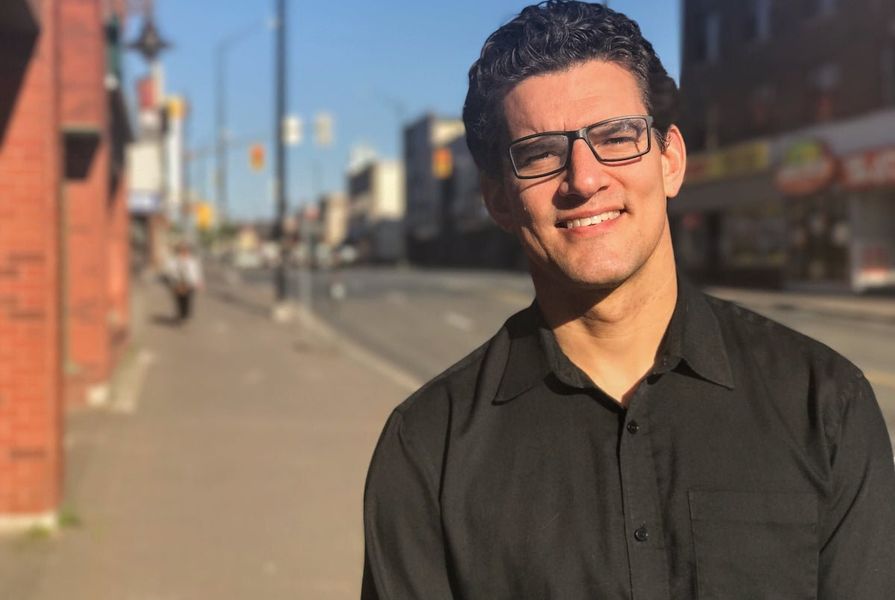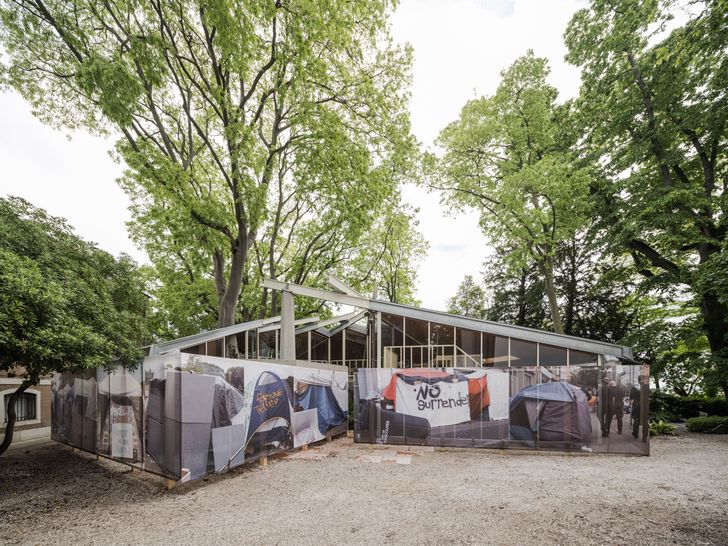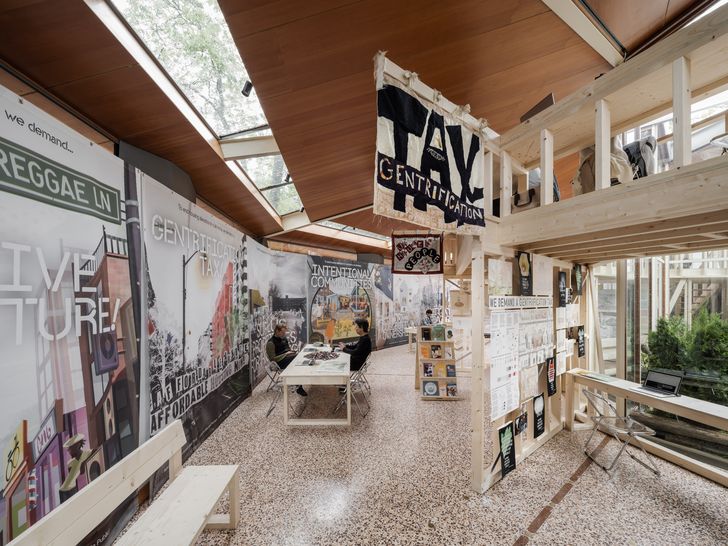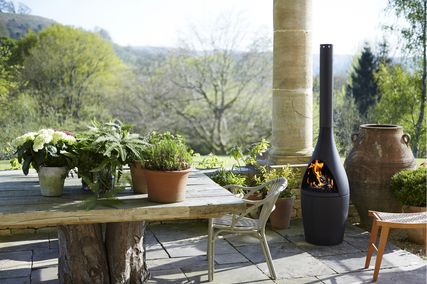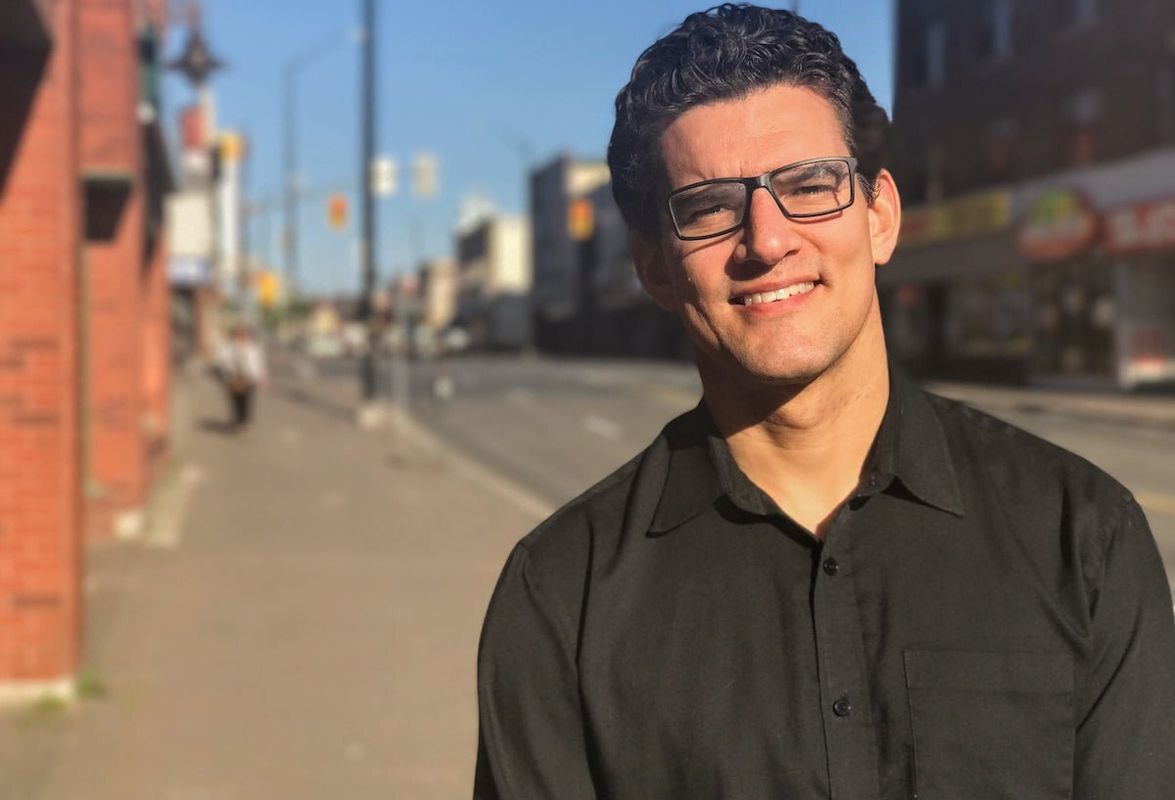David T. Fortin is a Canadian registered architect, a professor of architectural history, theory and design, and a citizen of of the Métis Nation of Ontario. He was the first person of Indigenous heritage to direct a school of architecture in Canada. His design practice works primarily with First Nations communities across Canada.
Fortin has twice co-curated Canada’s exhibition at the Venice Architecture Biennale. The 2023 exhibition, titled “Not for Sale,” transforms the Canadian pavilion into the campaign headquarters for the organization Architects Against Housing Alienation, which comprises 10 teams of architects, advocates and activists working on projects to alleviate the housing affordability and homelessness crisis, particularly among First Nations peoples in Canada.
Ahead of his appearance at the Living Cities Forum on 16 November, he spoke to ArchitectureAU editor Linda Cheng about architecture’s role in the path towards reconciliation.
Linda Cheng: The theme for the Living Cities Forum this year is going to be “infrastructures for life”. How do you interpret this theme and how do you think contemporary architecture fits into that?
David Fortin: I’ve got this Christi Belcourt painting in my living room. She’s a Métis artist whose artwork is very much about a bunch of living creatures and plants and they’re always composed in these beautiful ways.
The title of that painting is called Reverence for Life, which is important in a sense from trying to understand what you mean by life, and that life goes far beyond human life.
For me, the infrastructures for life means our positionality and our relationship with the living world and that is framed through all different kinds of education, information, the places where we live, but it’s also in stories, and different spiritualities and relationships with land, ceremony.
Infrastructures for life is interesting to me as a theme because it’s at the core of our positionality, in what we think life is, and our relationship to that life as one of many living things on this earth. It’s a very provocative topic.
I’m really interested in this idea that I’ve stumbled onto in the last year or so called “critical relationalism.” It’s out of an academic field a couple of European authors. Critical relationalism asks what relations matter.
I really feel for people working in design and architecture fields, myself included most days, often it’s a struggle of what do you prioritize. What are the most important things we need to focus on right now, because we have so many things that we’re trying to address as designers.
For me how it works with architecture and the living world is recognizing that our living relations with the non-human world are important, they deserve to be at the table. How do we prioritize the non-human world in our design processes in very meaningful ways that reflects a reverence for it, as critical to our own survival.
And really my interest in all of this that I really think that Indigenous knowledge and Indigenous epistemologies offer us really critical teachings that are location based, and geography based. I really believe in critical regionalism to a certain degree, but then beyond being regionalist, what does that mean?
What relations have we lost through colonization, through our disconnect with the places where we live, through a lot of the other work I’m doing with Architects Against Housing Alienation in Venice right now for the Biennale, through the commodification of the built environment.
“Not for Sale” the Canadian exhibition at the 2023 Venice Architecture Biennale.
Image: Maris Mezulis
In our world, I don’t think it’s too alarmist anymore to say that we’re dealing with multiple crises on our hands from an environmental crisis to a housing crisis to affordability crisis to now major armed conflicts around the world. We are on the verge of some very scary possibilities. The business-as-usual model is not going to serve us well collectively.
So we have to find out what relations matter. We have to find this out all of us individually and collectively.
I really believe that from that I’ve been very lucky over my career to have worked alongside many Indigenous knowledge keepers and been around elders in different countries and places and I can’t help but think that so much is there and the architectural community has ignored or not appreciated it because we’ve been focused on other kinds of relations. The design culture has distracted us.
LC: Speaking of your exhibition at the Venice Biennale, I thought your exhibition was really unique in the way that you’ve presented it not just as an exhibition of works but it’s an active, ongoing project. I also like the dichotomy of the Architects Against Housing Alienation organization, which speaks to land dispossession while the theme, “Not for Sale” is about the commodification of housing. Can you talk about how all the elements came together?
DF: We are an organizing committee of a campaign, not as curators. We almost had to restrain the way that we think as architects and not design an exhibit, but design a campaign – that was our first challenge to make sure we didn’t fall into traps of appealing to what an exhibit should be.
A lot of the work comes out of the make up of our team of six who came together and with two Indigenous people, four non-Indigenous people – the key word for me in this exhibit is alienation and really understanding the infrastructures of what that means to be alienated. For us collectively, we understood from the beginning that we’re interested in settler colonialism as an infrastructure, for our relationship to what we now perceive as Canada as a country – you’ll see when we write Canada, we write “c\a\n\a\d\a,” which comes from research by Patrick Stewart, who’s a Nisga’a architect, and a journal article Adrian [Blackwell] and I had published on the idea of property.
For me and for many First Nations and Indigenous people in Canada, the idea of owning land conceptually doesn’t make sense. One of the elders that I worked with on the property journal article said, I’ve never understood what people mean by [ownership]s. Do they think they own the trees? Do they think they own the bugs? And the birds living in the trees? What does that mean to own a piece of land?
“Not for Sale” the Canadian exhibition at the 2023 Venice Architecture Biennale.
Image: Maris Mezulis
So the idea for our exhibition starts from this question of how did our relations with the land change through settler colonialism? Through having surveyors come through, demarcate the land and assign it a value. Or actually, first of all, establish a police force to protect from Indigenous peoples from trying to get it back; fight off the Indigenous people; relocate them; and then assign it a value. And it now becomes an exchange value for people, and more and more people come, and you divide the land up into more and more pieces, and now you’re into this game of real estate.
So really settler colonialism is in Canada and in Australia a long process of land dispossession and enfranchising and benefitting other people who come to settle.
That in itself around the world has caused an alienation of relations to how we live. And when you put that on steroids in terms of free market capitalism, now you’re in a housing crisis situation, it’s such a complex thing.
Housing affordability and homelessness are on the rise in every one of our cities in Canada, we’re seeing tent cities all over the place now. This is not something that Canadians have identified with, but this is what happens when these things play themselves out over time.
So the exhibit was, we really wanted to show the world that Canada for many years, much like Australia probably, was one of the great places to move to. It was envisioned as a land of prosperity and opportunity, without ever telling people that that land you were getting was just recently stolen from First Nations people.
These are the roots of the problems in housing that we interpret as a group, and then we have the 10 teams who say as architects, we feel there’s a responsibility to try to envision something beyond that.
What are other solutions? How do we think of the idea of home as something that routes us back into place in different ways. It’s something that people have a human right to. It isn’t genderised, it isn’t racialized, it isn’t commodified and everyone may not be perfect but each of the 10 teams is a collective in itself who are working with boots on the ground, with communities who are trying to deal with these problems.
For us it’s a very motivating project because there’s a question of design agency. What can you do to design a better world. It’s very important to young architects and all architects. What is our future going to be and can we help make it better?
It’s an ongoing project and all ten teams are still working on moving those agendas forward.
LC: One of 10 teams is your team working on developing Home Building Design Lodges. Can you explain what that is and how it differs on from the tradition way that housing is delivered to First Nations peoples?
DF: A lot of that work is really inspired by the work of Alex Wilson and Silvia McAdam from One House Many Nations initiative, which is a First Nations grass roots organization who have been going a lot of small-scale home building that is built from the community up.
Alex is the first person I’ve seen that give a housing lecture where she started with the stars and their relationship to people.
She starts with a constellation that is meaningful for her community and it has its own name and this how she talks about housing. She continues to talks about the forest and the relationship between the forest and living as a sense of home and place in the world related to the stars. And then she talks about housing processes and the making of things and gets into a critique of Ikea and other things.
It’s a very powerful position. She’s not an architect, but she thinks of housing from a very different perspective.
Right now, housing on reserves is a kind of enforced commodity. The way that it works is the government gives communities X amount of dollars for housing and most of the communities have waiting list. The money is a fraction of what they need for their communities, which means they’re always in a position of wanting to maximize the houses, to help the number of families that they can build for.
Most communities don’t have a lot of capacity to build and manufacture their own homes. They don’t necessarily have people trained, they don’t have the resources. So they end up having to bring in non-Indigenous companies to design and build these homes.
The money comes from the government, filters through the chief and the council to the housing then goes out to non-Indigenous people who get the economic benefit from it, and First Nations people get sub-standard. It’s a weird system, if you follow the economic trail.
The idea of Home Building Lodges is simply the idea of how can Indigenous communities become producers of their own housing, using their own materials from their own lands.
We’re interested in pitching an idea that in 50 years, when you get a set of construction documents, why couldn’t they be in English and Cree, or Anishinaabe or Algonquin languages. And how would you design differently if you’re in an environment that was led by elders and knowledge keepers of your community, who understood the constellations, and how the language links to the land and to the stars, and that’s part of your house building process. Your people are employed through that and there’s a network of communities who are working together. Maybe one is building the prefabricated walls, one is building doors, one is doing the mechanical stuff. You’re building capacity, resilience, and moving away from dependency and housing becomes central to your identity as a community.
That’s what our project is about and we’re trying to move forward with a few communities to see if we can get this done with a few manufacturing facilities. The Design Building Lodge is a space for design grounded in each community’s values and language.
LC: On the topic of reconciliation through architecture, what do you think is architecture’s role in the path towards healing?
DF: It’s multi-pronged. The first path towards healing involves Indigenous voice, design sovereignty, empowerment. Architecture has the capacity to empower people. Part of that is honouring and recognizing Indigenous peoples’ presence on these lands, wherever you are. Part of it is also seeing the values and the cultures and the stories of the places where Indigenous peoples are. I think of that as Indigenous presencing. That can be a healing path because for Indigenous peoples, our cities, just like in Australia, have often been very violent places, scary places, and racist places. So it’s important to have cities and urban places that say ‘yes we recognise that you’re important here or you’re welcome here.’ Having spaces where you can see your culture is part of it.
But then it’s a double-edged sword as well because it can often be very tokenistic. And so that’s the part that architecture has a harder time doing independently.
The idea of Indigenous presence means also the value systems. This is where Indigenous and non-Indigenous values all align when it comes to things like the climate crisis.
It’s really testing what value systems you’re employing as a designer and do they align with the Indigenous reverence for life. And that’s across the board for designers and that’s a healing process for people.
Again, it has to be done with Indigenous people, otherwise it’s extractive.
There’s a lot of different layers to this question and this is where architecture has limitations.
Part of the problem that I always have is if Indigenous peoples aren’t making economic progress, if they’re not playing leading roles in the city, if their voices aren’t being heard, if you continue down the path towards economic disparity and homelessness and we continue the business as usual with resources extraction, then what are we saying by Indigenising? And it actually insults the teachings of the Indigenous elders.
By presencing Indigenous peoples, there needs to be follow through. As long as everybody understands that you can’t just put up an Indigenous painting on a wall and think it’s business as usual. It needs to come back to this question, this infrastructures of life question: how does our integration with the Indigenous teachings– how does our relationship with that – write path in a different direction.
LC: So how do we move past an architecture of symbolism and allegory. What are the subsequent steps?
DF: I really believe that education is really at the core. How I practice architecture is unfortunately very much tied to how I was taught to think about architecture.
Step two is to really infiltrate the way we teach and reposition how we do things. And that is going to involve much more engagement with First Nations elders and teachers which is challenging because of a capacity issue.
How do you learn to 3D fabricate things and utilize AI technologies but do it in a way that honours Indigenous teachings and moves us forward in our relationality with the land, as a priority, not as a subtext. How do these tools help you do that.
If you learn architecture in that way, generations will come and there’ll be a snowball effect. And you have practitioners now who know how to approach a design problem from a different set of priorities. Who are you designing for? What does design excellence mean to you? What does it mean for the community that’s it’s serving and for the animals and the waters? These are very tough questions in a globalized design culture.
LC: It’s like a kind of original critical regionalism. It’s critical regionalism before Kenneth Frampton.
DF: Yes exactly. We had amazing critical regionalism before colonization. And that was before we understood the idea of pluralverse.
One of the things that I will talk about is there’s an Indigenous teaching about icebergs. What you see of an iceberg is the visuality of the world: the clothing that you wear, the architecture that you build, even the food that you eat. But underneath the water is an entire constellation and epistemology of values and philosophies and languages tied to it. It doesn’t matter where you are in the world, we have multiples of these massive grounds of richness to them. That’s what creates great architecture.
What a richer place the world would be if architecture can maintain those stories and bring them back. There’s an infinite amount of inspiration there for designers moving forward that we haven’t tapped into.
David Fortin will be one of seven international keynote speakers at the 2023 Living Cities Forum along with Carles Baiges Camprubí (Spain), Keller Easterling (USA), Marina Tabassum (Bangladesh), Nashin Mahtani (Indonesia), Eva Pfannes (Netherlands), and Christian Benimana (Rwanda). For tickets, click here.

